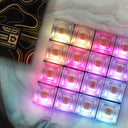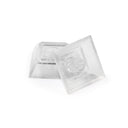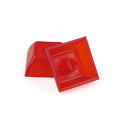Keybow 2040
by Pimoroni




A luxe all-in-one 16 key mini mechanical keyboard with hot swap clicky or linear switches and per key customisable RGB lighting.
Keybow evolves into its final form with a 4x4 grid of keys, and low latency input, high reliability and a super slim footprint courtesy of the brand new RP2040 chip from Raspberry Pi. The RP2040 microcontroller chip is incorporated neatly into the Keybow 2040 PCB, so it's a tidy all-in-one unit. We've added our favourite Kailh Speed switches (now available in clicky, linear or tactile varieties) and smart transparent DSA keycaps that look incredible when lit up with the fully customisable per-key RGB lighting.
You could use Keybow 2040 as a streaming deck for adjusting in-stream audio settings and switching easily between OBS scenes, as a capable midi controller for triggering clips, tracks, or effects in Ableton Live or as a customisable hotkey pad for programs like Photoshop. It's also handy for pasting frequently-used text or code snippets.
Features
- Powered by RP2040
- 2MB of flash memory.
- 16 (4x4 matrix) of low profile keys connected directly to GPIOs
- Kailh hot-swap switch sockets (for Cherry MX-compatible switches)
- Per key RGB LEDs driven by an IS31FL3731 PWM LED matrix driver
- A BOOTSEL button (this can also be used as a user switch)
- A reset button!
- Powered and programmable via USB-C
- Dimensions: approx 76mm x 76mm x 30mm (L x W x H, including switches, keycaps and feet)
- No soldering required!
- Comes with CircuitPython pre-installed
- PMK CircuitPython library
- Schematic
Includes
The clicky, linear and tactile kits contain everything you need* to assemble your own mini mechanical keyboard with high-quality clicky (Gold), linear (Silver) or tactile (Copper) Kailh Speed switches and clear DSA-profile key caps. The hot-swap Kailh sockets mean that assembly is super simple and there's absolutely no soldering required!
We also have a bare bones edition available, without keycaps and switches, for folks who would like to supply their own. The hot-swap sockets will work with Cherry-MX compatible switches and you'll need ones that have a recess on the underside for surface mount LEDs.
* A USB-C cable is not included, but we sell one here!
Getting started
This tutorial shows you how to assemble your Keybow 2040 - assembly is really straightforward and the only tool you'll need is a small Phillips screwdriver.
We're shipping Keybow 2040 with CircuitPython and all the necessary libraries pre-installed - it even comes set up with an example to get you going!
Software
Our good friend Sandy has written a swish CircuitPython library which makes it easy to program and customise your Keybow 2040. There are simple examples to show you how to control the LEDs and buttons, as well as fancy ones to show you how set it up as a USB input device or even a midi controller/sequencer.
You can watch Sandy's livestream where he chats about Keybow 2040 and how the library works here.
About RP2040
Raspberry Pi's RP2040 microcontroller is a dual core ARM Cortex M0+ running at up to 133Mhz. It bundles in 264kB of SRAM, 30 multifunction GPIO pins (including a four channel 12-bit ADC), a heap of standard peripherals (I2C, SPI, UART, PWM, clocks, etc), and USB support.
One very exciting feature of RP2040 is the programmable IOs which allow you to execute custom programs that can manipulate GPIO pins and transfer data between peripherals - they can offload tasks that require high data transfer rates or precise timing that traditionally would have required a lot of heavy lifting from the CPU.
-
Clicky keys
PIM565Out of stock£32.50 -
Linear (quiet) keys
PIM561£32.50 -
Tactile keys
PIM568£32.50 -
Bare (no switches/keycaps)
PIM567Out of stock£25.00
Keybow extras
Useful Keybow supplements!
Transparent keycaps
Funky transparent keycaps, for ultimate customisation!
-
 Keycaps for MX Mechanical Keyboard Switches (pack of 16) – KIT15 - Transparent+ £5.00
Keycaps for MX Mechanical Keyboard Switches (pack of 16) – KIT15 - Transparent+ £5.00 -
 Keycaps for MX Mechanical Keyboard Switches (pack of 16) – KIT11 - Transparent Red+ £5.00
Keycaps for MX Mechanical Keyboard Switches (pack of 16) – KIT11 - Transparent Red+ £5.00
Pastel keycaps
Perhaps you'd like something more delicate?
-
 Keycaps for MX Mechanical Keyboard Switches (pack of 16) – KIT2 - Light Green+ £5.00
Keycaps for MX Mechanical Keyboard Switches (pack of 16) – KIT2 - Light Green+ £5.00 -
 Keycaps for MX Mechanical Keyboard Switches (pack of 16) – KIT7 - Yellow+ £5.00
Keycaps for MX Mechanical Keyboard Switches (pack of 16) – KIT7 - Yellow+ £5.00 -
 Keycaps for MX Mechanical Keyboard Switches (pack of 16) – KIT4 - Pink+ £5.00
Keycaps for MX Mechanical Keyboard Switches (pack of 16) – KIT4 - Pink+ £5.00 -
 Keycaps for MX Mechanical Keyboard Switches (pack of 16) – KIT9 - Light Purple+ £5.00
Keycaps for MX Mechanical Keyboard Switches (pack of 16) – KIT9 - Light Purple+ £5.00
Rainbow keycaps
Or just go full rainbow!
-
 Keycaps for MX Mechanical Keyboard Switches (pack of 16) – KIT10 - Green+ £5.00
Keycaps for MX Mechanical Keyboard Switches (pack of 16) – KIT10 - Green+ £5.00 -
 Keycaps for MX Mechanical Keyboard Switches (pack of 16) – KIT21 - Purple+ £5.00
Keycaps for MX Mechanical Keyboard Switches (pack of 16) – KIT21 - Purple+ £5.00
Shop with confidence – we've been serving the hobbyist electronics, Maker, and retro gaming communities since 2012.
- Satisfaction or refund guarantee
- Worldwide shipping via mail or courier
- 57,000+ customer reviews
- Secure website and payments









